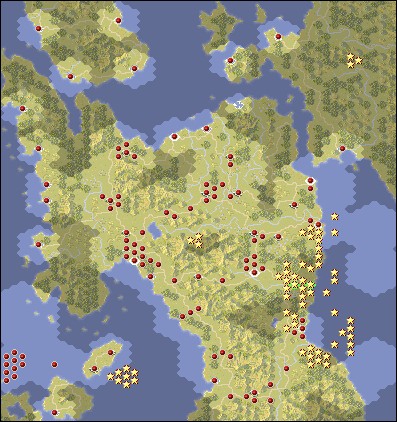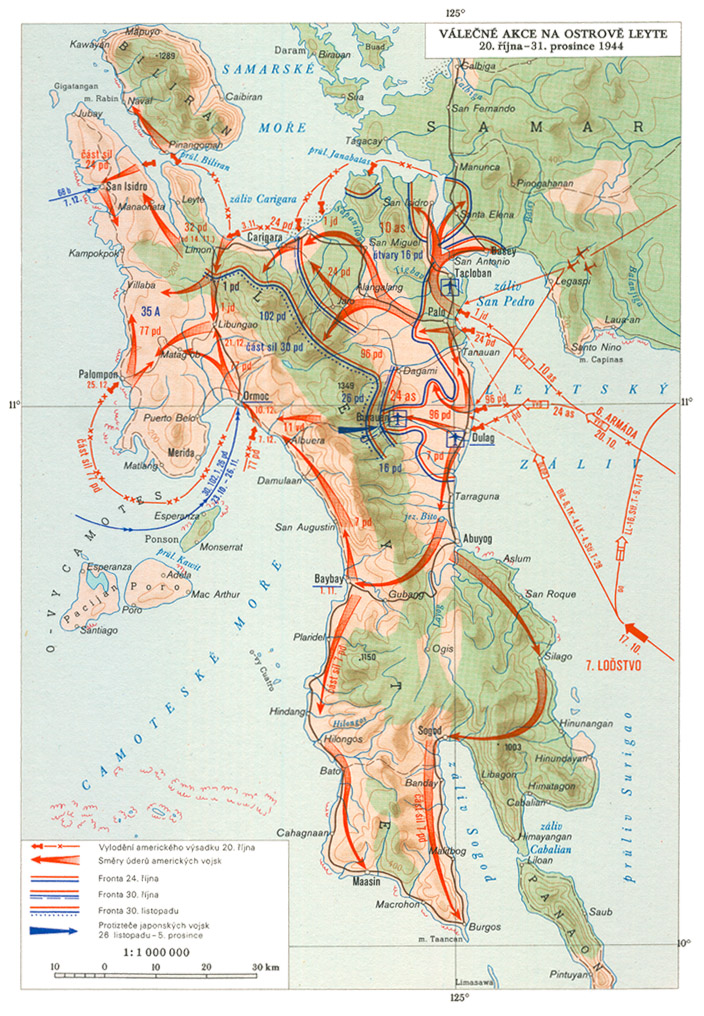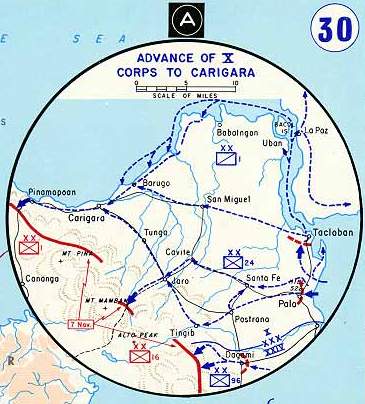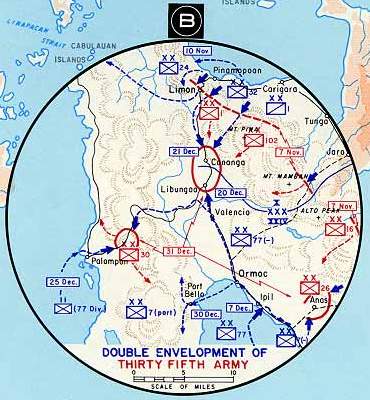| Operation codename: King Two |
Occupation of Leyte island should had been one of the decisive operations in the Pacific, in whose outcome will depend the fate of the Philippines and next conduct of the war with imperial Japan. Due to its location in the middle of the Philippine archipelago had become Leyte a place where Southwest Pacific forces with General MacArthur join Middle Pacific forces of Admiral Nimitz for a massive stroke, which will snatches the Philippines from Japanese hands. (Miloš Hubáček - Boj o Filipíny, Panorama 1990)
Article on English Wikipedia| Scenario in dates: |
| July 26, 1944: |
In Honolulu - Roosevelt meets with MacArthur and Nimitz to discuss strategy in the Pacific theater. MacArthur argues for an attack on the Philippines. Nimitz and the naval staff suggest the Philippines can be by-passed and Formosa should be the next major target. |
| September 12, 1944: |
In the Philippines - Three groups of US Task Force 38, with 12 carriers, conduct air strikes on Japanese positions on the Visayas or central Philippine islands. |
| September 14, 1944: |
In the Philippines - Three groups of US Task Force 38, with 12 carriers, conduct air strikes on Japanese positions on the Visayas or central Philippine islands. |
| October 10, 1944: |
United States - an escort carrier USS Midway (CVE-63) is renamed USS St. Lo, to free the name Midway for a new attack carrier (CV-41) and to commemorate an important victory of American troops in Normany who captured the strongly defended Frech town of Saint-Lô, on 18 July 1944. However, she will not enjoy the new name for a long time in active service, as two weeks later she will be sunk during the Battle of Leyte Gulf as the first vessel destroyed by a kamikaze attack. |
| October 17, 1944: |
In the Philippines - US Task Group 77.4 (Admiral TF Sprague) continues air strikes on Leyte, Cebu and Mindanao. US Task Group 38.4 (Admiral Davison) arrives with 4 carriers and launches air strikes on Luzon. Also, American minesweeping in Leyte Gulf begin and there are minor landings, by elements of the US Rangers, on the islands of Suluan and Dinagat at the entrance to Leyte Gulf. |
| October 17, 1944: |
In the Nicobar Islands - As a diversion for the American attack on Leyte, the British Eastern Fleet sends 2 carriers, 1 battle cruiser and lighter ships on a raid of the islands. Air strikes and shelling are carried out, causing damage. |
| October 18, 1944: |
In the Nicobar Islands - Elements of the British Eastern Fleet continue diversionary operations with further bombardment of the islands, causing more damage. |
| October 18, 1944: |
In the Philippines - The American escort carriers of TG77.4 concentrate air strikes on Leyte while the now 12 fleet carriers, in three groups from TF38, strike Luzon. |
| October 19, 1944: |
In the Nicobar Islands - Elements of the British Eastern Fleet continue diversionary operations with air strikes on the islands. Considerable damage is caused but the operation fails to divert Japanese attention from American operations in the Philippines. |
| October 19, 1944: |
In the Philippines - The American escort carriers of TG77.4 continue air strikes on Leyte. The US 15th Air Forces raids targets on Mindanao. The Japanese air forces suffer substantial losses in the ongoing American operations. Remaining aircraft are concentrated on Luzon in 1st Air Fleet (Admiral Onishi). |
| October 20, 1944: |
In North Borneo - Japanese naval forces assemble for a counterattack in the Philippines as part of Operation Sho-go. |
| October 20, 1944: |
In Japan - A carrier fleet, including 1 large carrier, 3 small carriers and 2 hybrid carrier-battleships as well as small ships, sails for the Philippines as part of Operation Sho-go. All carriers are almost without planes and pilots. This force, the Northern Force (Admiral Ozawa) is intended to draw off the main American naval forces operating around the Philippines, to the northeast. Meanwhile, the 2nd Striking Force (Admiral Shima) sets sail with 3 cruisers and 7 destroyers. |
| October 20, 1944: |
In the Philippines - Elements of the US 6th Army (Krueger) land on the east coast of Leyte. The 1st Cavalry and 24th Infantry Divisions of the US X Corps (Sibert) come ashore to the south of Tacloban, the 96th and 7th Infantry Divisions of US XXIV Corps (Hodge) land around Dulag. A total of 132,000 troops are landed during the day. Naval support is provided by the US 7th Fleet (Admiral Kinkaid). Additional naval support is provided the elements of the US 3rd Fleet (Admiral Halsey). Additional air support is provided by the US 5th Air Force. The defending Japanese 16th Division conducts a fighting withdrawal from the beachheads to prepared positions inland to await reinforcements. American forces capture Tacloban Airfield during the day but are unable to link the two beachheads. A few hours after the initial assault troops land, General MacArthur, the Supreme Commander of Allied Forces in the Southwest Pacifc, comes ashore and makes a radio broadcast to the people of the Philippines, recalling his promise to return. During the night, Japanese forces launch unsuccessful counterattacks against the beachheads. |
| October 21, 1944: |
In the Philippines - On Leyte, elements of US XXIV Corps capture Dulag Airfield. Tacloban village is taken by forces of US X Corps. American forces are unable to link the two beachheads. Ships of the US 7th Fleet and one group of US Task Force 38 (part of US 3rd Fleet) provide naval and air support to the land battles. Meanwhile, two groups of TF38 launch air strikes against targets on Panay, Cebu, Negros and Masbate. |
| October 22, 1944: |
In North Borneo - The Japanese fleet assembled at Brunei sets sail for the Philippines with the intention of destroying the American invasion fleet. The Center Force (Admiral Kurita) includes 5 battleships (including Yamato and Musashi), 12 cruisers and 15 destroyers. The Southern Force (Admiral Nishimura) includes 2 battleships, 1 cruiser and 4 destroyers. It is to rendezvous with the 2nd Striking Force (Admiral Shima) from Japan. |
| October 23, 1944: |
In the Philippines - On Leyte, the US 1st Cavalry Division (part of US X Corps) attacks northwest form Tacloban. To the right, armored forces attached to 7th Division (part of US XXIV Corps) capture Burauen. At sea, the Japanese Center Force (Kurita) is sited sighted off Palawan by two American submarines USS Darter (SS-227) and USS Dace (SS-247). The Japanese lose 2 heavy cruisers Atago and Maya to the submarines and demaged heavy cruiser Takao is ordered back to Borneo escorted by two destroyers. The report of the sighting, however, alerts the three groups of Task Force 38, east of the Philippines. Submarine Darter will be lost next day when will run aground on the Bombay Shoal. |
| October 24, 1944: |
In the Philippines - On land, elements of US 1st Cavalry land on Samar. The fighting on Leyte continues. At sea, Japanese aircraft, based on Luzon, attack US Task Group 38.3 (Sherman) and sinking the carrier USS Princeton (CVL-23). The Japanese Center Force (Kurita) is discovered by scout planes from US Task Group 38.2 and attacked throughout the day by all the carrier groups. The Japanese battleship Musashi is sunk and a cruiser is damaged and turns back. Center Force withdraws during the day. The Japanese Southern Force (Nishimura) is also sighted but American air strikes fail to cause significant damage. Admiral Oldendorf assembles a force in the Surigao Strait to block Southern Force. Meanwhile, Northern Force (Ozawa) locates TG38.2 and launches an air strike. The Japanese planes do not find the objective and land on Luzon. Late in the day, Admiral Halsey (commanding US 3rd Fleet) assembles his carriers and battleships to attack Northern Force, leaving Admiral Oldendorf to defend against Southern Force. During the night, Center Force reverses course. |
| October 25, 1944: |
In the Philippines - On land, the US 1st Cavalry Division continues advancing on the northeast coast of Leyte. Other elements of US X and US XXIV Corps, to the south, are inactive because of a lack of supplies. At sea, the Japanese Southern Force (Nishimura) and the 2nd Striking Force (Shima) engage American forces, commanded by Admiral Oldendorf, blocking the Surigao Strait. After suffering losses the Japanese withdraw. The Center Force (Kurita) passes through the San Bernardino Strait and engages US Task Unit 77.4.3 ("Taffy 3", Sprague) which is then reinforced by aircraft from TU 77.4.2 ("Taffy 2") as it attempts to retreat. Center Force suffers some losses and Admiral Kurita chooses to withdraw because he believes the aircraft are from US Task Force 38. While Center Force turns back, TU 77.4.3 is struck by Kamikaze strikes which hit 4 escort carriers, USS St. Lo (CVE-63) later sinks. These are the first significant Kamikaze attacks recorded. At the same time, TU 77.4.1 is also attacked by Kamikazes. Meanwhile, the Northern Force (Ozawa) is attacked TF 38. Only the carrier-battleships (Ise and Hyuga) survive the day. The Japanese aircraft carrier Chiyoda becomes the bigget World War II vessel to sink with all hands (1,470 dead). During the engagement, two groups of TF 38 turn back to attack Center Force but fail to arrive in time. USS Johnston (DD-557) destroyer, who after a brave fight sank in the Battle off Samar, will be found in 2019 on the seabed at a depth of 6,220 meters, making him the deepest known shipwreck. |
| October 26, 1944: |
In the Philippines - On land, on Leyte, elements of US XXIV Corps unsuccessfully attack Japanese positions on Catmon Hill, north of Dulag. The defenders fall back after the battle. Japanese reinforcements arrive at Ormoc. At sea, American air attacks continue to harass the retiring Japanese squadrons. Japanese cruisers Noshiro, Abukuma and Kinu and destroyer Hayashimo are sunk. Over Mindoro Island is shot down transport Ki-49 by Hellcats from USS Wasp (CV-18). On board as passenger dies Hiroyoshi Nishizawa, was the most successful Japanese fighter ace of the war. |
| October 27, 1944: |
In the Philippines - On land, on Leyte, the US 7th Division (part of US XXIV Corps) captures Buri Airfield. Meanwhile, the Tacloban airstrip becomes operational and the US 9th Fighter Squadron flies the first mission by Philippines based American fighters since 1942. At sea, a group of 3 carriers commanded by Admiral Sherman attacks Japanese shipping around Luzon, sinking destroyers Fujinami a Shiranuhi. There are also air strikes on Luzon. |
| October 28, 1944: |
In the Philippines - On Leyte, attacks by US XXIV Corps around Dagami make slow progress and suffer heavy losses. To the north, the US 1st Cavalry Division (part of US X Corps) encounters heavy resistance near Carigara and is held up. At sea, carrier groups under the command of Admiral Davison and Admiral Bogan conduct air strikes. |
| October 29, 1944: |
In the Philippines - On Leyte, elements of US XXIV Corps capture Abuyog , south of Dulag, while Catmon Hill is cleared and the advance to Dagami continues. At sea, carrier groups under the command of Admiral Davison and Admiral Bogan conduct air strikes. In two days, they destroy almost 100 Japanese planes for a loss of 15 American aircraft. The carrier USS Intrepid (CV-11) is damaged by a Kamikaze attack. |
| October 30, 1944: |
In the Philippines - On Leyte, troops of US 7th Infantry Division (part of US XXIV Corps) take Dagami. As sea, two carriers are badly damaged by Kamikaze attacks as the ships of US Task Force 38 begin to withdraw toward Ulithi. |
| November 1, 1944: |
In the Philippines - On Leyte, Japanese forces in the line are reinforced by 2000 men for the base at Ormoc. The defending Japanese forces now consists of forces of the 36th Army (General Suzuki) including the original 16th Division and the new 30th and 102nd Divisions. The attacking US 7th Division (part of US XXIV Corps) captures Baybay. Offshore, an American destroyer USS Abner Read (DD-526) is sunk, and 5 others are badly damaged by Japanese Kamikaze and bombing attacks. |
| November 4, 1944: |
In the Philippines - On Leyte, American forces advance west of Dagami around "Bloody Ridge". In the San Bernandino Strait, the Japanese submarine I-41 torpedoes light cruiser USS Reno (CL-96) escorting aircraft carrier USS Lexington (CV- 16). This is the first successful attack a ship operating with American fast carriers by a Japanese submarine after almost two years. After a great deal of effort, the capable crew of Reno manages to keep their vessel above water so that it can be towed for repairs to Ulithi Atoll. |
| November 7, 1944: |
In the Philippines - On Leyte, the US 96th Division captures Bloody Ridge. Near the north coast, the American advance is held by Japanese defenses. |
| November 9, 1944: |
In the Philippines - On Leyte, another 2000 troops of the Japanese 26th Division arrive at Ormoc. The transporting warships are forced to withdraw before all the supplies can landed. |
| November 10, 1944: |
In the Philippines - On Leyte, heavy fighting is reported near Carigara. Elements of the US 24th Division (part of US X Corps) are amphibiously transported west along the north coast from Carigara toward Belen. |
| November 11, 1944: |
In the Philippines - Aircraft from 8 carriers of US Task Force 38 attack a Japanese convoy off Leyte, near Ormoc. Four destroyers (Shimakaze, Wakatsuki, Hamanami and Naganami), 1 minesweeper (W-30) and 4 transports (carrying nearly 4,000 troops) are sunk. |
| November 21, 1944: |
In the East China Sea - Northeast of Formosa, the US submarine Sealion (SS-315) attacks an convoy of japanese battleships Jamato, Nagato and Kongo and the rest of the First Fleet after lost battle of Leyte Gulf. Battleship Kongo and destroyer Urakaze are sunk. |
| November 21, 1944: |
In the Philippines - On Leyte, the US 32nd Division, advancing from the north coast, is held in the Ormoc Valley by Japanese forces. US 7th Division begins attacks north from Baybay toward Ormoc. |
| November 25 1944: |
In the Philippines - On Leyte, the advance of American forces is contained by Japanese defenses. Some US paratroopers advance across difficult terrain west of Burauen. At sea, Task Group 38.2 and Task Group 38.3 conduct further raids on Luzon and surrounding waters. The air strikes, involving planes from 7 carriers, sink the cruisers Kumano and Yasoshima. Kamikaze attacks damage 4 of the carriers. |
| November 26 1944: |
In the Philippines - On Leyte, Japanese forces launch night attacks against US forces west of Burauen. |
| November 27, 1944: |
In the Philippines - Around Burauen, on Leyte, Japanese force continue to attack and receive a small number of parachute reinforcements. There is heavy fighting around Burauen airfield. At sea, the battleship USS Colorado (BB-45) and 2 light cruisers are damaged in Kamikaze attacks. |
| November 28, 1944: |
In the Philippines - On Leyte, Japanese night attacks continue. There is heavy fighting at Kilay Ridge in the north and around Buri and Burauen. |
| November 29, 1944: |
In the Philippines - Japanese attacks on Kilay Ridge, on Leyte, continue. American forces successfully counterattack. At sea, the battleship USS Maryland (BB-46) and 2 destroyers are seriously damaged by Kamikaze attacks. |
| December 7, 1944: |
In the Philippines - On Leyte, the US 7th Division continues attacking northward toward Ormoc. The US 77th Division lands about one mile south of Ormoc. There is some Japanese resistance. One of the 12 escorting destroyers is sunk by a Kamikaze attack. It is the USS Ward (DD-139) which fired the first American shot in World War II, when it engaged a Japanese submarine before the attack on Pearl Harbor. Severely damaged Ward is sunk by deck guns of destroyer USS O´Brien (DD-725) led by William W. Outerbridge who was a captain of Ward in Pearl Harbor. |
| December 8, 1944: |
In the Philippines - On Leyte, the US 77th Division advances from its beachhead to within 1 mile of Ormoc. Attacks by the Japanese 26th Division, near Buri, are repulsed by other US forces. |
| December 9, 1944: |
In the Philippines - On Leyte, a small number of Japanese reinforcements are successfully landed at Palompon on the west coast, northwest of Ormoc. To the south of Ormoc, the US 77th Divsion continues expanding its beachhead. |
| December 10, 1944: |
In the Philippines - On Leyte, the US 77th Division captures Ormoc, the main Japanese base on the island. Japanese forces are now mostly concentrated around Palompon. |
| December 17, 1944: |
In the Philippines - On Mindoro, American forces capture San Jose Airfield. On Leyte, parts of US X and XXIV Corps record advances against Japanese positions. |
| December 19, 1944: |
In the Philippines - It is decided that the Japanese 35th Army on Leyte is no longer to be reinforced or supplied. Nonetheless, fighting continues to the north of Ormoc and throughout the northwest of the island. |
| December 21, 1944: |
In the Philippines - On Leyte, advances by US X Corps and US XXIV Corps link up in the center of the Ormoc Valley. Isolated Japanese forces continue to resist in the area. |
| December 22, 1944: |
In the Philippines - On Leyte, there is fighting around Palompon where the Japanese forces on the island are now concentrated. |
| December 25, 1944: |
In the Philippines - On Leyte, part of the US 77th Division makes an amphibious move from Ormoc to San Juan, on the west coast of the island, north of Palompon, where the Japanese forces are concentrated. The landing is unopposed. General MacArthur announces that the Leyte campaign has ended with Japanese losses totalling 113,221. |
| December 31, 1944: |
In the Philippines - On Leyte, various Japanese counterattacks in the northwest are repulsed by American forces. Up to this point, the Japanese have suffered about 70,000 casualties, almost all killed, in the battles on Leyte. American casualties number 15,500 dead and wounded. The US 6th Army is being withdrawn from the island, in preparation for the invasion of Luzon, and the US 8th Army is replacing it. In the hills above Silad Bay, a tragic event occurs when the commander of the 32nd US Cavalry Reconnaissance Troop (Mechanized) Herman Bottcher dies during a Japanese mortar attack. Bottcher´s men had spent more than 40 days behind enemy lines when they were suddenly attacked by Japanese troops. Captain Herman Bottcher, who also achieved the rank of captain in the Republican Army during the Spanish Civil War, distinguished himself as a hero of the Battle of Buna in New Guinea. His merits stand out especially in light of the fact that he was a German who had only held American citizenship for one year at the time of his death. |
|
| Literature sources: |  | Jordan, David, Wiest Andrew: Atlas Of World War II., Ottovo nakladatelství, 2006, Praha |  | Hoyt, Edwin P.: Leyte Gulf, Beta - Pavel Dobrovský, 2002, Praha |  | Hubáček, Miloš: Boj o Filipíny (Fight for Philippines), Paseka, 2005, Praha, Litomyšl |  . . | Swanston, Alexander & Malcolm: The Historical Atlas of World War II, Columbus, 2007, Praha |  | Thomas, Evan: Sea of Thunder, Naše vojsko, 2010, Praha |  | Hata, Izawa, Sh, Ikuhiro, Yasuho, Christopher: Japanese army air force fighter units and their aces, 1931-1945, DOBROVSKÝ s.r.o., 2007, Praha |  . . | Šnajdr, Miroslav: Flying Marines, Akcent, 2015, Třebíč |  | Bruce, George: Die Seeschlachten des XX. Jahrhunderts (Sea Battles of the 20th Century), Area, 2007, Praha |  . . | Sims, Edward H.: Největší vzdušné bitvy (The Largest Air Battles), Toužimský & Moravec, 2002, Praha |  | Pejčoch, Ivo: Obrněná technika 10 (Armored machinery 10), Ares, 2010, Praha |  . . | Óoka, Šóhei: Nobi, Vyšehrad, 2007, Praha |  . . | Newark, Tim: Turing the Tide of War, Ottovo nakladatelství, 2003, Praha |  | Hrbek, Jaroslav, Hrbek Ivan: Vítězství přichází z moře (Victory comes from sea), Naše vojsko, 1999, Praha | Pejčoch, Ivo: DUKW, HPM No. 1 a 2/2003
Pejčoch, Ivo: Ka-Mi, HPM No. 2/2005
Pejčoch, Ivo: Lehký tank Typ 95 Ha-Go (Light tank Type 95 Ha-Go), HPM No. 1/1994
Pejčoch, Ivo: M10 Wolverine, HPM No. 11/2007
|
|





